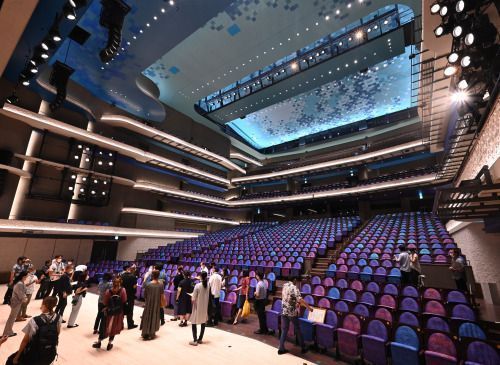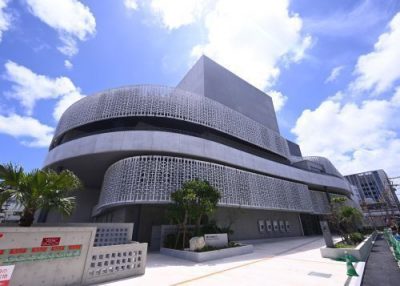Naha’s new Cultural Arts Theater incorporates elements of Shuri traditional textiles and the Okinawan Sea, and hopes to become a beacon for arts and culture

Naha Cultural Arts Theater NAHArt’s large theater, which was opened to the media July 18 (photograph by Yasuhide Matayoshi)
July 19, 2021 Ryukyu Shimpo
Naha City opened the doors of its new Naha Cultural Arts Theater NAHArt (New Community Center) in Kumoji to local media organizations on July 18. The center will open to the public October 31. The large theater seats around 1,600, and there will be a smaller theater that seats around 260-300. The design of the theater incorporates Okinawan elements such as shuriori textiles, una (a public square) and the ocean.
The exterior of the theater is wrapped in a shuriori-themed louver. The lobby is styled after an una, where anyone can relax while the theater is open. From the lobby you can see studios and practice rooms through glass.

The small theater, which can be used as a multi-purpose hall with its convertible stage and seating
The interior of the large theater is designed to look like one is inside the ocean, with the design on the ceiling resembling looking at the swaying surface of the ocean from the ocean floor. The walls are made with limestone. There are levels of seating.
The smaller theater is themed yellow to resemble the Okinawan royal family kimonos, and shuriori designs are sprinkled throughout. Both the large theater and small theater each have a stage, and a large and small studio, and four small practice rooms.

The shuriori design wrapping the exterior of Naha Cultural Arts Theater NAHArt, which hopes to become a landmark in Naha
NAHArt is working to become the center of Naha’s stage performances, arts and culture, and a place for Naha residents to interact. Naha mayor Kimiko Shiroma commented, “we have built a spectacular facility, and I thank from the bottom of my heart the cooperation from the workers and local community members. From now our job is to breathe life into this new vessel. I hope that many people come to interact and use this place as a center for arts and culture.”
NAHArt’s operating expenses total around 14.71 billion yen; which comes from a general grant of around 7.1 billion yen, 6.6 billion yen from municipal bonds, and other sources. On July 18 there was also a thank you ceremony for the 26 companies involved with the construction.
(English translation by T&CT and Sam Grieb)
Previous Article:Yukiko Miyagi and Fusako Shida become the first living national treasures in Ryukyu Buyo
Next Article:OPG speculates Delta variant causing rise in infections among US military-associated persons
[Similar Articles]
- Ryukyuan dance displayed in China at 2016 Chengdu International Sister Cities Youth Music Festival
- National Theatre Okinawa celebrates 10th anniversary of its opening
- Mezzo soprano soloist Sayaka Shigeshima signs a two-year contract with the Weimar National Theater in Germany
- Exhibit of Ryukyu Kingdom era garments reproduced by Kyoko Shukumine displays woven colors that can’t be expressed with paints
- Okinawa traditional arts event attracts 11,000 people
 Webcam(Kokusai Street)
Webcam(Kokusai Street)


